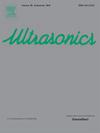Electro-acoustic study of airborne standing-wave acoustic levitators based on arrays of ultrasonic transducers
IF 3.8
2区 物理与天体物理
Q1 ACOUSTICS
引用次数: 0
Abstract
Airborne acoustic levitation has seen great advances in recent years largely due to the development of devices utilizing arrays of compact, low-power, piezoelectric transducers. In particular, standing wave acoustic levitators are acoustic cavities, consisting of either a single piezoelectric boundary opposing a reflector or two opposing piezoelectric boundaries operating simultaneously. The multiple intra-cavity reflections can be significant enough to generate voltages and currents at the electrical port due to the direct piezoelectric effect, providing valuable information about the optimal operating conditions of the cavity. In this work, we present a theoretical model that employs two planar piezoelectric boundaries to analyze the electrical response (voltage and current) at the cavity’s electrical port and to identify the resonance conditions as a function of two key parameters: the cavity length and the phase configuration of the boundaries. We implemented a numerical approach to estimate the voltage and the current in cavities with pairs of planar and spherical boundaries. Additionally, we conduct a comparative study between numerical simulations and experimental results using cavities with spherical cap boundaries to validate our approach. The results demonstrate that source-reflector (S-R) and source-source (S-S) cavities can be set to resonance by tuning the cavity length from directly monitoring in real time the electric response of both S-R and S-S cavities, with voltage (current) exhibiting direct (inverse) correlation with the acoustic pressure amplitudes.
基于超声换能器阵列的机载驻波声悬浮器电声研究
近年来,由于采用紧凑、低功耗、压电换能器阵列的设备的发展,机载声悬浮技术取得了很大的进步。特别地,驻波声悬浮器是由与反射器相对的单个压电边界或同时工作的两个相对的压电边界组成的声腔。由于直接压电效应,多次腔内反射足以在电端口产生电压和电流,为腔的最佳工作条件提供了有价值的信息。在这项工作中,我们提出了一个理论模型,该模型采用两个平面压电边界来分析腔电端口的电响应(电压和电流),并确定共振条件作为两个关键参数的函数:腔长度和边界的相位配置。我们实现了一种数值方法来估计具有平面和球面边界的空腔中的电压和电流。此外,我们还进行了数值模拟和实验结果的对比研究,以验证我们的方法。结果表明,通过直接实时监测S-R腔和S-S腔的电响应,可以通过调整腔长来实现源-反射腔和源-源腔的共振,且电压(电流)与声压幅值呈直接(反)相关。
本文章由计算机程序翻译,如有差异,请以英文原文为准。
求助全文
约1分钟内获得全文
求助全文
来源期刊

Ultrasonics
医学-核医学
CiteScore
7.60
自引率
19.00%
发文量
186
审稿时长
3.9 months
期刊介绍:
Ultrasonics is the only internationally established journal which covers the entire field of ultrasound research and technology and all its many applications. Ultrasonics contains a variety of sections to keep readers fully informed and up-to-date on the whole spectrum of research and development throughout the world. Ultrasonics publishes papers of exceptional quality and of relevance to both academia and industry. Manuscripts in which ultrasonics is a central issue and not simply an incidental tool or minor issue, are welcomed.
As well as top quality original research papers and review articles by world renowned experts, Ultrasonics also regularly features short communications, a calendar of forthcoming events and special issues dedicated to topical subjects.
 求助内容:
求助内容: 应助结果提醒方式:
应助结果提醒方式:


